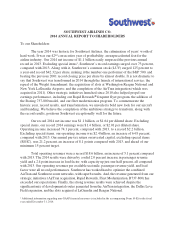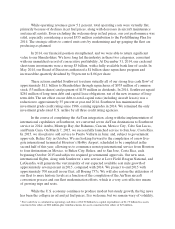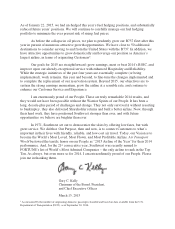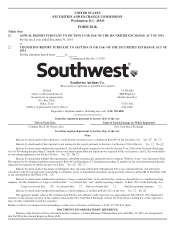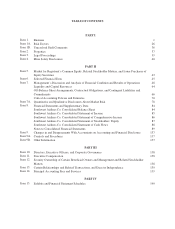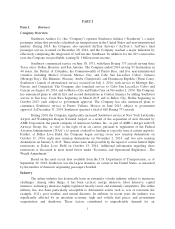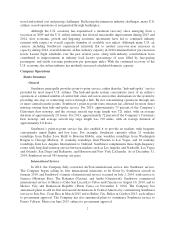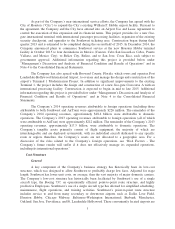Southwest Airlines 2014 Annual Report Download - page 11
Download and view the complete annual report
Please find page 11 of the 2014 Southwest Airlines annual report below. You can navigate through the pages in the report by either clicking on the pages listed below, or by using the keyword search tool below to find specific information within the annual report.As part of the Company’s near-international service efforts, the Company has agreed with the
City of Houston (“City”) to expand the City’s existing William P. Hobby airport facility. Pursuant to
the agreement, the Company and the City have entered into an Airport Use and Lease Agreement to
control the execution of this expansion and its financial terms. This project provides for a new five-
gate international terminal with international passenger processing facilities, expansion of the existing
security checkpoint, and upgrades to the Southwest ticketing area. Construction began during third
quarter 2013 and is estimated to be completed during the second half of 2015. In December 2014, the
Company announced plans to commence Southwest service at the new Houston Hobby terminal
facility in October 2015 to four destinations in Mexico (Cancun, Cabo San Lucas/Los Cabos, Puerto
Vallarta, and Mexico City), to Belize City, Belize, and to San Jose, Costa Rica, each subject to
government approval. Additional information regarding this project is provided below under
“Management’s Discussion and Analysis of Financial Condition and Results of Operations” and in
Note 4 to the Consolidated Financial Statements.
The Company has also agreed with Broward County, Florida, which owns and operates Fort
Lauderdale-Hollywood International Airport, to oversee and manage the design and construction of the
airport’s Terminal 1 Modernization Project. In addition to significant improvements to the existing
Terminal 1, the project includes the design and construction of a new five-gate Concourse A with an
international processing facility. Construction is expected to begin in mid to late 2015. Additional
information regarding this project is provided below under “Management’s Discussion and Analysis of
Financial Condition and Results of Operations” and in Note 4 to the Consolidated Financial
Statements.
The Company’s 2014 operating revenues attributable to foreign operations (including those
attributable to both Southwest and AirTran) were approximately $226 million. The remainder of the
Company’s 2014 operating revenues, approximately $18.4 billion, were attributable to domestic
operations. The Company’s 2013 operating revenues attributable to foreign operations (all of which
were attributable to AirTran) were approximately $212 million. The remainder of the Company’s 2013
operating revenues, approximately $17.5 billion, were attributable to domestic operations. The
Company’s tangible assets primarily consist of flight equipment, the majority of which are
interchangeable and are deployed systemwide, with no individual aircraft dedicated to any specific
route or region; therefore, the Company’s assets are not allocated to a geographic area. For a
discussion of the risks related to the Company’s foreign operations, see “Risk Factors - The
Company’s future results will suffer if it does not effectively manage its expanded operations,
including its international operations.”
Cost Structure
General
A key component of the Company’s business strategy has historically been its low-cost
structure, which was designed to allow Southwest to profitably charge low fares. Adjusted for stage
length, Southwest has lower unit costs, on average, than the vast majority of major domestic carriers.
The Company’s low-cost structure has historically been facilitated by Southwest’s use of a single
aircraft type, the Boeing 737, an operationally efficient point-to-point route structure, and highly
productive Employees. Southwest’s use of a single aircraft type has allowed for simplified scheduling,
maintenance, flight operations, and training activities. Southwest’s point-to-point route structure
includes service to and from many secondary or downtown airports such as Dallas Love Field,
Houston Hobby, Chicago Midway, Baltimore-Washington International, Burbank, Manchester,
Oakland, San Jose, Providence, and Ft. Lauderdale-Hollywood. These conveniently located airports are
3

